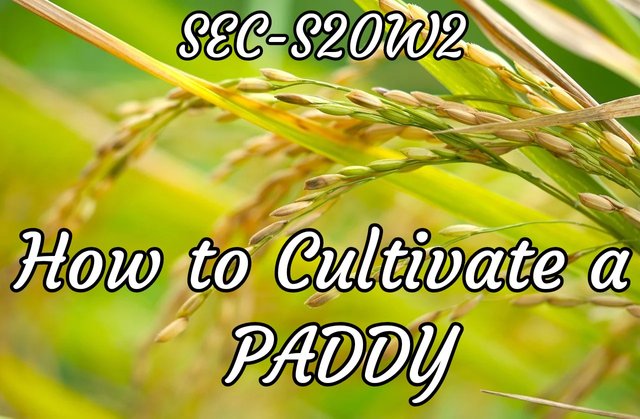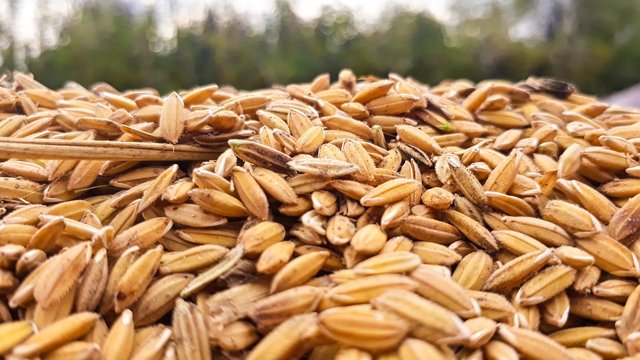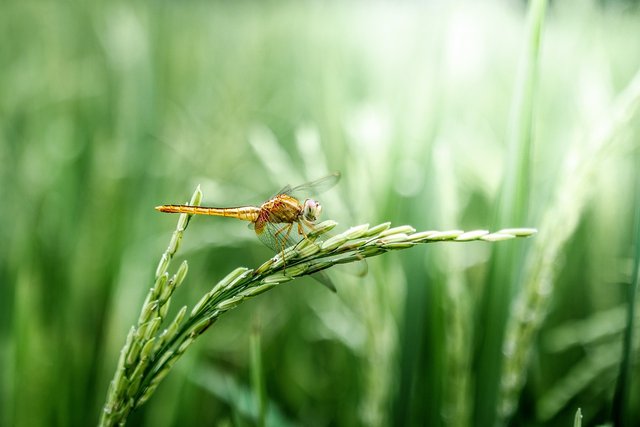Hello Teachers,
I am happy to be part of this week's class. Learning about paddy this week opened my eyes to so many important informations I didn't know. Having said that, let me present my homework below.
What is the method of rice seedbed preparation and what steps are taken in preparing the soil for rice cultivation |
|---|
The first method of rice seedbed preparation is sure selection. Rice can be grown in two main areas: lowland areas and upland areas. Lowlands are where we have the availability of water, while the upland areas have more sunlight with water.
After site selection, you move to land/soil preparation. Proper soil preparation is important for rice production to reduce competition with weeds. In a case where the soil is fragile, zero tillage is recommended. The soil should be well mixed with manure and preferably loamy soil.
After land preparation, we sow the seed. The actual time for sowing should be adjusted with the time of the rain. Weeding exercises should be performed at least twice, say 2-3 weeks and 5-6 weeks after sowing.
Some important steps to be taken in preparing the soil for rice cultivation
• Plowing and tilling of the land.
• Checking and testing the alkalinity of the soil.
• Be sure of the soil nutrients.
• Compost manure should be applied to the soil.
• Create drainage.
What is the importance of planting rice seeds at the right time? |
|---|
The right time is very important when it comes to doing anything, so planting rice seed shouldn't be left out. Rice thrives mainly in the rainy season in Nigeria.Bit is a staple food commonly used in making various foods. Rice can be planted between April and July, when we usually have a heavy rainfall.
Planting rice seeds at the right time gives the crop access to be free from diseases like brown leaf spot and blast, be free from insects, and yield better and better quality crops. When rice seeds are planted during this season, it gives the crop free access to getting a good amount of water from rain.
How is regular irrigation and fertilizer applied after sowing rice seeds? |
|---|
After sowing rice seed, irrigation is important, and for the case of rice, it requires more irrigation, like watering the crop for at least 6-10 days of sowing. This allows the soil to remain moist, and if possible, there should be the availability of 5–10 cm of water on the land for proper germination of the crop.
Fertilizers should be applied after sowing, although there are different types of fertilizers, so you can decide which one for your type of rice. The fertilizer should be applied 2-3 inches by the side of the crop and 1-2 inches below. The urea fertilizer should be applied 6-7 weeks after sowing day.
Potassium and phosphorus should be well mixed into the soil at planting season.
What are the major pests and diseases of rice crops, and how can they be controlled? |
|---|
Mole Cricket: These insect are very destructive because seeds and roots are the only thing they feed on. It cut the tillers from the ground level and develop gap in crop.
Controlled: They can be controlled during land preparation by proper irrigation of land every 3-4 days after planting.
Rice Bugs: These insects sticks during early stage of rice crop. Both the adult and the nymphs sucks all the nutrients out of the grains. This leads to discolored grains.
Controlled: They can be controlled by keeping the field area free from weeds. You can also kill these insects by using net during early morning hours and late noon.
False smut: This is a seed born disease and if not taken care of, may affect seed germination.
Controlled: Treat seeds with hot water for 10 minutes. Keep the field clean and maintain humidity in field by wetting and drying.
Narrow leaf spot: This disease occurs majorly in rice growing region.
Controlled: No chemicals control currently for it but treating seeds with hot water can reduce the disease.
What are the next steps after harvesting the paddy and what are the steps to be taken to preserve the paddy? |
|---|
After harvesting paddy, you separate the grains from the rest of the crops which is called threshing then, we move to removing non- grain/ immature crops which is called cleaning. Also, we have to cut crops to the threshing location and then finally leave the cut crops in the fields to dry under the sun.
To preserve rice, it is important to dry the rice after harvesting, store in a clean dry place possibly an air free bag to prevent fungal attacks. It is good for rice to have enough air and always inspect the place the paddy is kept to be sure it's safe.

I invite @goodybest @okere-blessing @tripple-e



Downvoting a post can decrease pending rewards and make it less visible. Common reasons:
Submit
Upvoted. Thank You for sending some of your rewards to @null. It will make Steem stronger.
Downvoting a post can decrease pending rewards and make it less visible. Common reasons:
Submit
Observations and suggestions:
A very good topic brought up by lowland areas and upland areas. Good for planting in lowland areas. Water is readily available here due to which proper seed production is possible. Yes, if rice plants are planted at the right time then the diseases are very less like: species attack is very less and fungal attack is also seen relatively less. If the land retains water for 6 to 10 days, the amount of weeds in that land is very less. The narrow leaf disease is called BLB or (bacterial leaf blight). You have a nice discussion but generally fertilizer is applied in three parts in paddy fields.
Feedback:
Downvoting a post can decrease pending rewards and make it less visible. Common reasons:
Submit
Very informative post! Want to know more about how important soil quality is for rice cultivation. Can you share some more details?" Thank you for sharing so much.
Downvoting a post can decrease pending rewards and make it less visible. Common reasons:
Submit
We produce rice not only for our livelihood but also as feed for cattle and even feed for poultry. From paddy we get many other materials such as paddy stalks and even straw or straw that cattle live by eating. Good luck to you
Downvoting a post can decrease pending rewards and make it less visible. Common reasons:
Submit
Hello!
I’m glad to hear you found this week’s class on paddy so enlightening! 🌾 Your homework is very well-structured and highlights important aspects of rice cultivation, from seedbed preparation to post-harvest preservation.
Your points on site selection and soil preparation are crucial for a successful yield, and I appreciate how you emphasize the importance of timing in planting. Your insights on pest and disease control are also very practical! 🌱
Thanks for sharing such detailed information; it really contributes to our understanding of rice farming. Keep up the great work! 🍚😊
Downvoting a post can decrease pending rewards and make it less visible. Common reasons:
Submit
TEAM 5
Downvoting a post can decrease pending rewards and make it less visible. Common reasons:
Submit